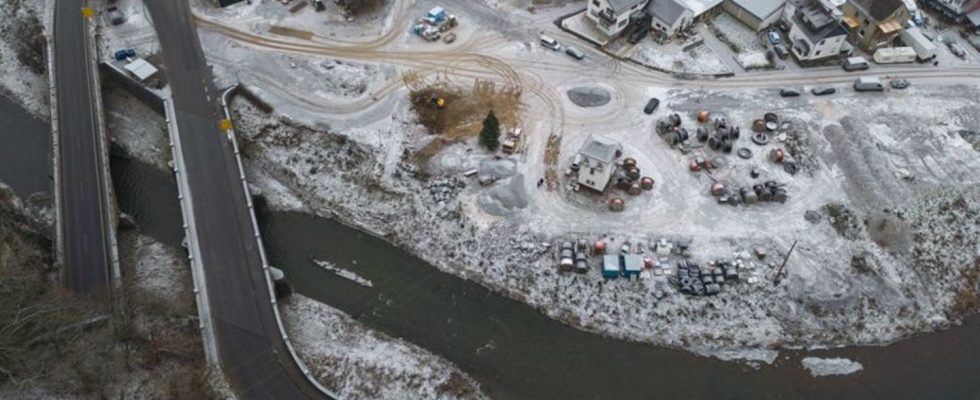Two and a half years after the deadly flood in the Ahr Valley, many people are deeply exhausted. Houses are still being torn down or remain untouched.
Tim Himmes gradually rebuilt his parents’ house in Schuld an der Ahr after the flood disaster. “It’s like living on a construction site. You can’t finish,” says the 23-year-old, pointing to the slabs with which he wants to pave the path to the house. Then it’s the turn of the barn.
And the electricity should now be placed underground, he says. The showman family is still waiting for the fiber optic connection. “They promised us that a long time ago, about a year after the flood,” says Himmes and laughs. Two and a half years after the disaster that left at least 135 dead, there is still a lot to do and many people are exhausted.
High burden on residents
The effects of the flood disaster on people’s mental health are “massive and long-term,” reports the President of the Rhineland-Palatinate State Chamber of Psychotherapists, Sabine Maur. Many residents of the Ahr Valley are burdened “by the long duration of the reconstruction, the ongoing construction sites, the lengthy disputes with authorities and insurance companies, the ongoing financial and family worries.”
“Nothing can be done quickly or without bureaucracy here. That was the case three or four weeks after the flood, when no one was there,” says hotelier and restaurateur Wolfgang Ewerts. “I feel worn out like an old cleaning rag. I’ve never been so exhausted,” says the entrepreneur, who has rebuilt his home and his business in Insul since the flood and has continued to invest.
“The booking situation is good.” Many of his guests now asked: “Did you also experience flooding here?” Then he points to the screen above the reception, on which photos in a continuous loop document how intense the water masses were on the 14th/15th. July 2021 devastated his inn with the beer garden on the Ahr.
The bridge in Insul is still missing, says Ewerts. “But a lot is back, a lot of the ruins are gone and a lot of things are more beautiful than before.” On the other hand, little has happened on the central square on the Ahr in Schuld. Piles of various stones and huge wooden cable drums indicate that progress will soon be made. Here and there new houses are being built or restored in the area. In between there are still completely muddy buildings that were gutted after the flood disaster, but have not been touched since.
Depressive illnesses and addictions
Post-traumatic stress disorders, as in the initial phase, have become less common, but depressive illnesses and addictions are increasing, says psychotherapist Maur. Among those seeking help, many of whom have to wait far too long for a therapy place, there are now also many people “who initially perhaps thought they could cope on their own or were unsure about therapy.”
Gerd Gasper has been back in his completely renovated house in Altenburg since late autumn 2022. The yard is currently being made and everything should be ready in a few weeks. People are slowly coming back to the Altenahr district, but the young people are still missing, reports the 82-year-old. “And everyone is busy with themselves.” Houses in the area are still being demolished. In between there are tiny houses as emergency accommodation – and construction cranes.
Gerd Gasper is not complaining. He has always pitched in since the disaster. “At one point I had already lost courage.” Now he is confident again and is caring for his wife, who is now in a wheelchair, probably as a result of the rescue operation with a helicopter winch in the afternoon after the deadly flood.
With a colorful carnival scarf, Gasper managed to draw the attention of a pilot to himself and his wife through the attic window. The couple spent the terrible hours in the attic in great distress. “The water stopped three steps from the storage tank.”
Packed up the essentials
The constant rain on the Ahr and the flood images from the north and east of Germany at the beginning of January did not scare Gasper and hotelier Ewerts, who have lived in the idyllic valley for decades. “The Ahr has kept itself under control,” says Gasper. The flooding in the north is of course also bad for those affected, but completely different, says Ewers. “It comes slowly and slowly goes.” On the Ahr it came very suddenly – and with enormous power.
Tim Himmes says that as a precaution in the constant rain at the beginning of the year, his family packed up the essentials and hung the trailers on the cars. “So we can get away quickly.” The muddy and smelly masses of water not only flooded the family’s house and yard in the summer of 2021, but also took away cars and rides. “If that happens again, we’ll all be gone.”

